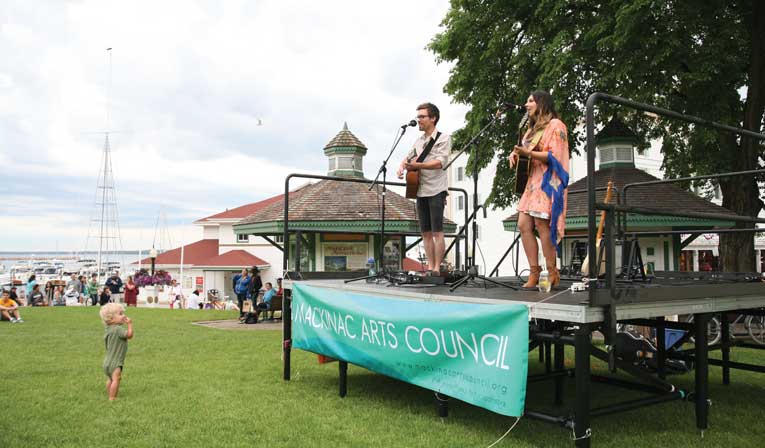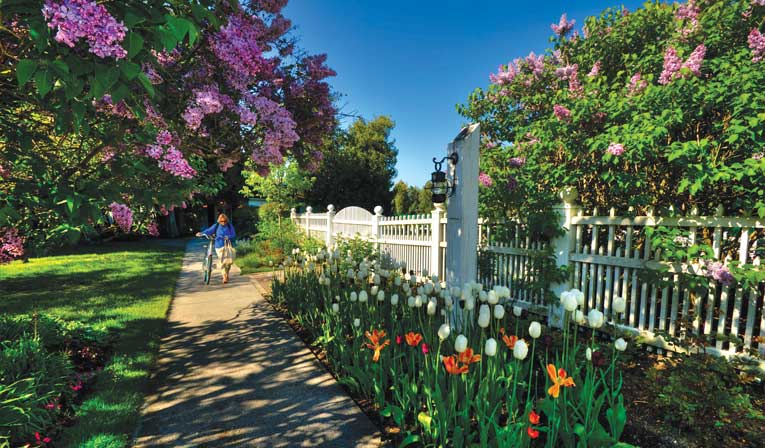Photo Courtesy of Mackinac Island Tourism
Take a Step back in time on Mackinac Island.
Take a Step back in time on Mackinac Island.
Charmingly perfect and anchored to its picturesque past of horse and buggies, grand homes and stately hotels, Mackinac Island, Michigan — located where Lake Michigan and Lake Huron converge — remains much the same as it was in 1897, when town leaders banned automobiles. A traffic jam on the island is when three carriages pause in front of the Grand Hotel’s golf course. Street sounds don’t include blaring horns and screeching brakes, but rather the jangle of harnesses and the clip clopping of horse hooves on cobbled streets.
But we’re not just talking about late 19th-century Mackinac Island — we’re talking about present-day. Phil Porter, director of Mackinac State Historic Parks (MSHP), summered on the island as a child, completed an internship here during college and then started working for MSHP in 1976 (and never left). He says the island has one of the largest collections of pre-1850 historic structures in the Midwest. This long list includes Michigan’s oldest hospital, the 1828 Post Hospital, and the oldest public building, the 1780 Officers’ Stone Quarters. Both buildings are located in Fort Mackinac. The Mission Church, built in 1829-30, is the state’s oldest church, and the gable-roofed McGulpin House, built in 1780, is the oldest home in Michigan.
Despite the fact that the island is considered the “Jewel of the Great Lakes,” early settlers didn’t choose this remote island for its beauty, but its location. Dating back to the late 1680s, the Straits of Mackinac was a major nexus for fur traders. By 1815, John Jacob Astor’s American Fur Company (AFC) was fur-trading central. It was here on Market Street that the AFC’s agents and clerks built their homes next to a large warehouse used for processing furs.
Today, many of these historic buildings are museums, open for tours and located in the downtown next to the many shops, restaurants, art galleries and, of course, bike and horse rentals.
Fortified history
Constant battles between the French, British, Americans and Native Americans led to the establishment of forts along the Great Lakes coastline. Still remaining today are Fort Mackinac on the island and the even older Fort Michilimackinac on the mainland in Mackinaw City. In 1715, the French fortified the settlement of Michilimackinac — the summer destination for thousands of French and Native American fur traders.
During the Revolutionary War, when those pesky Colonials were giving them a hard time, the British — who controlled Fort Michilimackinac by then — moved it across the straits to Mackinac Island and changed the name to Fort Mackinac.
After the war, the Americans occupied Fort Mackinac until the British recaptured it during the War of 1812. Two years later, in 1814, the Americans tried a power grab but failed. When the British were defeated, the fort fell into American hands again. Since then, the only British who have come back are part of the 1.5 million tourists who visit the island each year.
Rising on the south bluff of Mackinac Island, Fort Mackinac now overlooks the charming island town and the bay just beyond. Reenactors dressed in 19th-century garb fire cannons over the ramparts and shoot muskets on the green for show. Lunch and dinner are served inside the Fort Mackinac Tea Room and outside on the ramparts. The fort’s 14 rooms are open for touring.
Can’t get enough early frontier life? Fort Michilimackinac hosts a variety of reenactments, including battles, a French wedding and the arrival of the voyageurs who chanted songs (in French, of course) to keep pace. Women in long, flowing dresses perform domestic chores, such as candle dipping, hand-washing laundry and soap making.

Photo Courtesy of Mackinac Arts Council
Mackinac Island Tidbits
 How to say it
How to say it
You can blame the French and British for the area’s confusing spelling. Mackinac and Mackinaw are both pronounced “mak-in-aw.” The French, who first occupied the area, spelled it Mackinac, but when the British took over Mackinaw City, they opted for the -aw spelling.
The Bridge
Known as the “Mighty Mac” or just “The Bridge,” the 26,372-foot Mackinac Bridge is the third-longest suspension bridge in the Western Hemisphere. It spans the Straits of Mackinac and connects Michigan’s Upper and Lower Peninsulas. Take the 5-mile walk across the bridge this Labor Day during the 60th Annual Mackinac Bridge Walk.
Horse power
During the season, more than 500 horses live on the island. Although a few remain on the island year-round, the majority come over on the ferries in May and return to the mainland in late October. Much like the running of the bulls in Pamplona, Spain, watching the horses trot down the streets to and from the ferries is always quite the sight.
West side story
Follow the winding cliff road that runs up the west edge of the island. Spectacular 19th-century homes dot this route. With sweeping views of the water and the Mighty Mac, these homes are a myriad of architectural styles: Colonial revival, stick or shingle style, Queen Anne, Victorian and neoclassical revival — all fronted by lovely and well-tended gardens.
Bridge Photo Courtesy of Michigan Fitness Foundation; Horses photo by Jane Ammeson
Photo Courtesy of Mission Point Resort
Grandeur of the Grand
The majesty of the island may best be reflected in the magnificence of the Grand Hotel, which is now celebrating its 130th anniversary. When the Grand first opened in 1887 — set high on a bluff overlooking the Straits of Mackinac — it was one among a thousand luxury resort hotels in the United States. Now, the Grand, with its ornate cupolas, bay windows, gables, balconies and classic columns, is one of only 12 or so remaining from that era.
The hotel’s opulence is centered on old-fashioned style. White slatted rockers line the three-story-tall porch, which, at 660 feet, is the longest in the world.
Each of the 393 lavish rooms in the Grand Hotel has a different style and theme, including the Hollywood Suite, the Jane Seymour Suite and the “Somewhere in Time” Suite — named after the 1980 movie starring Jane Seymour and Christopher Reeves that was filmed on the island.
A vast emerald green lawn slopes towards the hotel pool where Esther Williams (ask your grandfather about her) filmed scenes for the 1947 movie, “This Time for Keeps.” The gardens brim with more than 100,000 annuals and perennials, including tulips, daffodils, geraniums, roses, peonies, lilies, daisies and begonias.
During high tea in the parlor, the background noise consists of clinking china and the soft sounds of a tuxedoed pianist playing a grand piano. Dinner in the Main Dining Room is a formal affair, with men required to wear a coat, tie and slacks. At the very top of the Grand, the Cupola Bar is the best place for a late night drink, with its panoramic view of the Straits and Mackinac Bridge.
It’s all very, well, grand.
Local flavors
Back in the early 1900s, fudge shop owners would turn on electric fans, wafting the scent of chocolate, sugar and cream out onto the busy streets of Mackinac Island. Windows were set up to show fudge being made in large copper kettles or being rolled out on slabs of marble. It was an advertising success. Despite a plethora of restaurants, fudge is now the major food group on the island. During peak tourist season, the combined output of the island’s fudgeries is 10,000 pounds per day; tourists are often affectionately called fudgies.
Doing personal research, I’ve determined (though I’m still working on it) there’s no such thing as bad fudge on Mackinac Island. But if you’re looking for a taste of sweet history, check out Murdick’s, which opened in 1887 and was the first fudge shop on the island.
The Mac attack
Before CNN founder Ted Turner competed in the 1970 Chicago Yacht Club Race to Mackinac — the longest freshwater race in the world — he somewhat derogatorily described Lake Michigan as “a millpond.” The angry lake gods showed him a thing or two by sending winds as strong as 60 mph. Of the 167 starters, 88 withdrew; though Turner completed the race, he acknowledged that Lake Michigan was indeed more than a millpond. But things could have been worse: During the 1911 race, winds clocked in at 82 mph.
Chicagoan Matt Gallagher, owner of the Endeavour, a Beneteau Oceanis 37 sailboat (which he sails in the race every year) says: “When you look at the boats back when the race first started, you realize there were some very good boats and no matter what has changed, it’s still the forces that move the boats — the wind and water — that make the race.” No matter the weather, Gallagher considers a visit to Mackinac Island after the race the highlight of his summer.
Not ready for the big-time race? Nowhere near as grueling as the Race to Mackinac, the fun, family-oriented Pink Pony Fourth of July Sailboat Race — sponsored by the Pink Pony Patio Bar and the Chippewa Hotel — is open to all sailboats. No entry fee is required, and an after party and awards ceremony is held at the Mackinac Island Yacht Club immediately after the race.

Photo Courtesy of The Grand Hotel
Lilac power
The annual Mackinac Island Lilac Festival is a 10-day celebration of all things lilac. The island’s love of these fragrant flowers dates back to the Jesuit missionaries who visited here in the late 1600s and planted masses of lilacs. More than 300 years later, some of these flowers remain and are considered to be the oldest living lilacs in the country.
This year’s festival takes place on June 9-18. Festival activities include the horse-driven Grand Lilac Parade, which has the distinction of being the world’s longest horse hitch parade; garden tours; wine tastings; A Taste of Mackinac culinary event; Mackinac Island Dog and Pony Show; fireworks, Irish dancers; free outdoor concerts; and boat cruises.
Beyond the downtown
There’s a totally different vibe on the other, less crowded side of the island; it can be reached by horse, bike, kayak or boat. You can walk there, too, but it’s a little bit of a hoof — pardon our pun. Pass the entrance to Fort Mackinac and follow the narrow roads that meander through the woods. Don’t miss the 50-foot-wide limestone Arch Rock and Skull Cave, where Wawatam, a Native American, hid English trader Alexander Henry during the Fort Michilimackinac uprising in 1763.
Bike or hike the road circling the island’s 8-mile coastline for views of the surrounding waters and land.
Three island cemeteries offer a sobering view of early island life — one of hardship and early death. Soldiers are buried at the Post Cemetery, while Saint Anne’s Cemetery shelters the oldest grave on the island: That of young Mary Biddle, the daughter of successful fur traders, who died in 1833.
Come ashore
There are several ways to get to the island but driving a car isn’t of them. There’s a small airport on the north side of the island for private planes. Ferries to the island leave from Mackinaw City or St. Ignace, located just north of the Mackinac Bridge.
Half the fun of a Mackinac Island experience is a ride aboard Shepler’s Ferry. This three generation, family-owned and operated business has been plying these waters for more than 70 years. Shepler’s offers lighthouse cruises, night sky cruises, private charters and a not-to-be-missed Fourth of July fireworks viewing experience.
For boaters, the lovely Mackinac Island State Harbor is open from May 15 to October 15. Nestled under the bluff in an inland bay, the marina has a total of 80 slips: Six seasonal and 74 transient. The marina’s amenities include a dog run, grills, an immigration station for those traveling from Canada, pumpout, shore power, restrooms, showers and water. Downtown is just steps away, and you can always catch the island’s version of a cab — a horse and buggy — to take you places.
On the mainland, the Mackinaw City Marina offers 78 transient slips, pumpout, 30- and 50-amp power, gas and diesel, water, cable TV, Wi-Fi, bathrooms, showers, laundry, a swimming pool and whirlpool, a recreation area, grills, picnic tables and a dog walk.
The 136-slip St. Ignace Public Marina features 30- and 50-amp power (and 200 amps for large slips), gas and diesel, water, cable TV, Wi-Fi, wells up to 120 feet, 24-hour security, showers, laundry, grills, picnic tables and a dog run.
…And stay ashore
For those who want to lodge on-land, there are many one-of-a-kind, family-owned resorts, hotels and inns to choose from. In addition to the Grand Hotel, Mission Point Resort is an award-winning, historic resort located on the island’s “sunrise side.” The 18-acre property boasts an 18-hole putting course, a fitness center, five restaurants, croquet and bocce ball lawn games, and even a movie theater.
Island House Hotel, established in 1852, overlooks the harbor. Enjoy a cup of coffee on the waterfront veranda and terrace, or rent a bike at the curbside Island House Bike Shop.
Chippewa Hotel Waterfront is yet another impressive waterfront hotel, located in the heart of downtown Mackinac Island. This hotel is home to the Pink Pony Patio Bar, a favorite spot for boaters. The hotel offers 31 guest rooms and 26 luxury suites.
Located on the waterfront behind the historic Bay View Bed and Breakfast, you will find the colorful studio and gallery of Noel Skiba. This award-winning, third generation artist can often be found painting somewhere on the island during the summer months. With a style of painting compared to Monet, she often paints spontaneously on site to capture an event or landscape. She can even be commissioned to paint your boat and family during your visit to the island.
From the first sight of the approaching harbor and a ride on a horse and buggy, to eating freshly-made fudge and taking in the view from a rocking chair on the Grand Hotel’s porch, Mackinac Island opens the world of the past in a delightful, memorable way.
Calendar of Events
 June 2–4
: Titanic at the Grand
June 2–4
: Titanic at the Grand
June 10 & 17:
Purple Pig Roast at Mission
Point Resort
June 9–18:
Lilac Festival
June 15:
A Taste of Mackinac
June 22 – August 17
: Every Thursday, Music in
Marquette Park
June 30 – July 2:
Grand Hotel 130th Anniversary Celebration
July 3
: The Pink Pony Fourth of July
Sailboat Race
July 4
: Star Spangled Fourth of July
at Fort Mackinac
July 4
: An All-American Picnic at
Fort Mackinac
July 15–18:
Chicago Yacht Club Race to Mackinac
July 19
: Round the Island Race
August 12:
Mission Point Mac to Mac Regatta
August 18–20:
Mackinac Island Fudge Festival
September 1–4
: Grand Hotel’s Labor Day
Jazz Weekend
September 2:
Horns Bar Labor Day Regatta
September 4:
The 60th Annual Mackinac
Bridge Walk
October 27–29:
27th “Somewhere in Time”
Weekend at Grand Hotel
October 29–30: The Grand closes for the season
Photo Courtesy of WMTA





